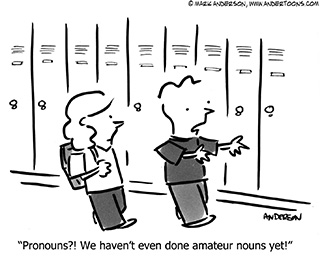A Question of Singular Importance

Richard Fienberg Running Hare Observatory
Every astronomer should belong to the AAS, shouldn’t he? For generations, the word “he” in such a question was understood to cover both men and women. During the latter half of the 20th century, though, feminists and others began objecting to this construction. Substituting “she” for “he” wasn’t exactly an improvement, so many writers started using “he or she,” “he/she,” or “s/he,” all of which are rather clunky and distracting. Worse, none of these approaches address the growing recognition that some people don’t feel comfortable in either the “he” or “she” category. If only the English language had a gender-neutral singular pronoun!
It may surprise you, but more and more dictionaries and grammar guides now say that English does have a gender-neutral singular pronoun, and that it’s “they.” In this view, the following is perfectly acceptable: Every astronomer should belong to the AAS, shouldn’t they? If that seems wrong, or at least not quite right, you could rewrite the question: All astronomers should belong to the AAS, shouldn’t they? But you don’t have to rewrite it, according to an increasing number of language authorities.Why bring this up here? To help improve the quality and consistency of print and electronic communications with our members, I recently created a style guide for the AAS Executive Office. It codifies such things as the formats of dates (e.g., “3 April 2015” rather than “April 3, 2015”) and times (e.g., “8:30 pm” rather than “8:30 P.M.”). As I explained to my fellow AAS staffers, style is a matter of preference: it’s perfectly acceptable to write “8:30 pm,” “8:30 PM,” “8:30 p.m.,” or “8:30 P.M.,” but it looks better if we all use the same format. We decided to go with “am” and “pm” not because those are right and the others are wrong (they’re not), but because we simply prefer them over the other forms.
I also prepared an “English 101” refresher that addresses common grammatical errors. Grammar involves questions that have definitive right or wrong answers. An example is subject-verb agreement: a singular noun takes a singular verb (e.g., “he writes”), and a plural noun takes a plural verb (e.g., “they write”). Incorrect grammar (e.g., “she write” or “they writes”), like incorrect spelling or usage (e.g., “she rites” or “they right”), gives the reader an unfavorable impression of the writer and, depending on the nature of the error, may even convey the opposite of the intended meaning.
When I distributed the style guide and grammar refresher to my Executive Office colleagues, I said that the documents could be, and should be, revised from time to time — not only to deal with new questions, but also to accommodate the ongoing evolution of the English language and possible changes in our style preferences. The first question that came up was how to deal with gender-specific pronouns, and the second question was whether the first was an issue of style or grammar.
I knew that the answer to the second question was “both.” For the style guide, I’ve added a statement to the effect that gender-specific pronouns should be avoided in cases where the person(s) referred to are not specifically identified and could therefore be of any gender. For the grammar refresher, I was going to suggest the “he or she” construction till I started checking references and found near-universal agreement that it’s OK to use “they” in place of “he or she.” Not only is this practice common in English-language speech (e.g., “I’m going to ask a friend if they can come over”), but it’s even common in some rather famous English-language writing (e.g., “I would have everybody marry if they can do it properly” — Jane Austen). Accordingly, I’ve added a statement to the English 101 refresher saying that it’s OK to use “they” as a singular pronoun but that where possible the text should be rewritten to avoid it, since there are still lots of people (including me) for whom such usage grates upon the ears, rightly or wrongly.
As a corollary, I added one other thing to the AAS style guide: Whenever we create a form to collect demographic data and the form includes a question about gender, we need to provide not two, but three possible answers: Male, Female, and Other. This was recommended by the AAS Working Group on LGBTIQ Equality (WGLE) and is consistent with the approach used by the Human Rights Campaign.


